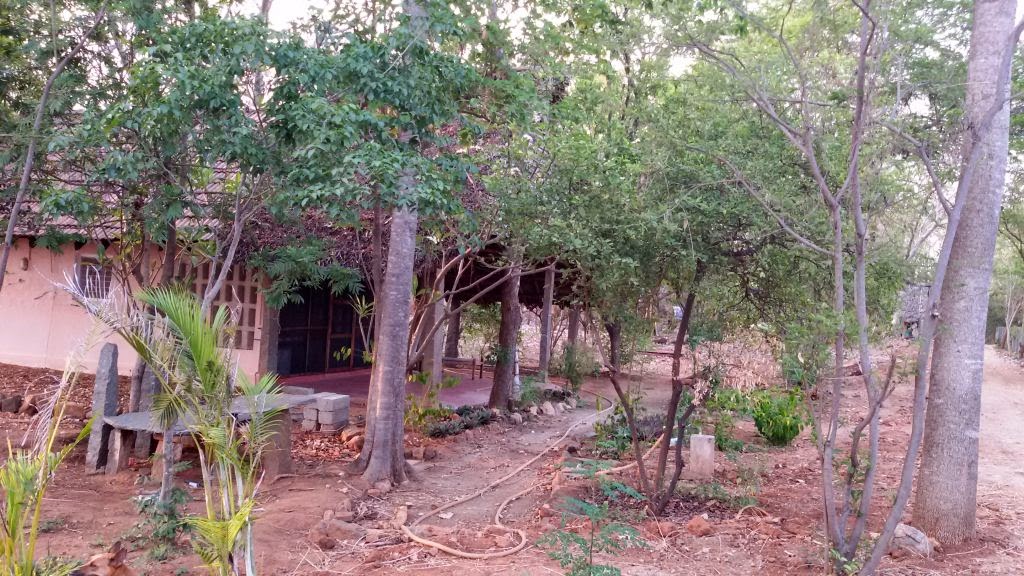The Jackfruit (Palapazham in Tamil) is a species of tree of the genus of the Mulberry family. It is believed to have originated in the Indian southwestern rain forests. Archeological findings have revealed that the Jackfruit Tree was cultivated in India 3000 to 6000 years. Although the Jackfruit Tree is well suited to tropical lands, with careful tending it can also grow in Tiruvannamalai District. I first learnt of this surprising fact some years ago visiting a friend’s house and noticing a very handsome, fruit laden tree in their small compound situated near Thiruvoodal Street, near the busy part of town.
The Jackfruit is a huge tree that grows to as high as 30 meters, higher than the mango tree. During the season, each tree may bear as many as 250 large fruits making them the largest tree-borne fruits in the world. The fruit varies widely in size and weighs from 3 to 30 kg, and has an oblong or round shape measuring 10 cm to 60 cm in length and 25 cm to 75 cm in diameter.
 |
| Jackfruit Tree |
In South India two varieties of Jackfruit predominate: varikka and koozha. Varikka has a slightly hard inner flesh when ripe, while the inner flesh of the ripe koozha fruit is very soft and almost dissolving.
The fruits’ outer surface is covered with blunt thorns like projections, which become soft as the fruit ripe. Its interior consists of orange-yellow coloured edible bulbs. Each bulb consists of sweet-flavored sheaths that enclose a smooth, oval, light-brown colour seed.
 |
| The spiny outside reveals the fruit bulbs inside |
The fruit is cut in a similar fashion as larger fruits like watermelon. White, gummy latex oozes from the cut ends even in ripe fruit but to a lesser extent than in the unripe ones. The latex problem can be overcome by applying coconut oil on the hands or by rubbing the cut sections with fresh cut lemon. The thick rind that runs through the middle of the fruit is then removed, and the whole section is twisted few turns in order to loosen individual bulbs.
The seeds from ripe fruits are edible and said to have a milky, sweet taste. They may be boiled, baked or roasted. When roasted the flavor of the seeds is comparable to chestnuts
 |
| Succulent Fruit |
The wood of the Jackfruit Tree is used for the production of musical instruments, furniture, doors, windows and in roof construction.
 |
| Seeds of Jackfruit with protective skins |
This species can expand naturally because its fruit, once it falls to the ground and opens; is eagerly eaten by small mammals. The seeds are then dispersed by these animals, which allows the Jackfruit to compete for space with other tree species.
--- oOo ---
Jackfruit in Mythology
Lord Shiva while on a hunt happened to hear a sweet voice in the jungle. He was surprised to find that it belonged to a tribal girl, "Koolivaka", a girl of immense beauty. The solitude of the forest area and beauty of the girl, made the Lord lustful. He informed Koolivaka of his wish and told her to wait for him until he returned from his hunt.
Koolivaka, who was a devotee of Parvathi prayed to the Goddess to save her from the predicament of displeasing her by having a relationship with Lord Shiva. The Goddess revealed to Koolivaka that in a previous birth she was Mansawini, a servant in the retinue of the Goddess. One day the serving girl happened to breast-feed baby Lord Vinayaka. Parvati angry that a servant should feed her baby, cursed her to be born in a outcaste family. But to lessen the curse, Parvati set out that her servant while being fated to be born a chandala would get the opportunity to breast-feed the son of Shiva.
Devi told the girl that she herself would take on the form of Koolivaka and deceive Lord Shiva. She also informed Koolivaka that the son born from the deceitful union would grow up to be the killer of Jalandhara, a powerful Asura.
Thus the Goddess in the form of Koolivaka started swinging on a creeper attached to a Jackfruit Tree and waited for the arrival of Lord Shiva. A child with divine power was born through this holy union. Lord Shiva arranged a buffalo for the protection of the child. This divine child who came to be known as "Chathan" was given to Koolivaka to raise. Vishnu Maya or Chathan is a concept in Hinduism that refers to the power to create illusions. Koolivaka thus became the mother of Chathan, son of Lord Shiva fulfilling the boon of Parvathi.
After spending years with Koolivaka, Chathan riding on a buffalo started on a journey to Kailas. When he was about to reach Kailas he realised that Nandikeshwara would not allow him to enter Kailas in his present form. So he took the form of Lord Vishnu. On seeing their son, Shiva and Parvathi were very happy and hugged him. Lord Shiva blessed him saying, "You invoked the form of Vishnu by Maya. So you will be known as Vishnu Maya." Fulfilling his destiny, Chanthan challenged the Asura Jalandhara to battle, and defeated him. After his victory, Chathan returned to his native place to live among the poor to who he offered his protection.
--- oOo ---
The Jackfruit is one of the three auspicious fruits of Tamil Nadu, along with mango and banana, known as the mukkani. These are referred to as ma-pala-vaazhai (mango-jack-banana). The three fruits (mukkani) are also related to the three arts of Tamil (mu-Tamizh).






















_.jpg)




























